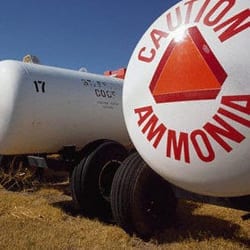Natural gas availability in Mexico is restricted, and output of ammonia and fertilizers has plummeted since the late 1990s, with farmers among the hardest hit. Twenty years after NAFTA came into force, the country is more dependent on food imports than ever. President Peña Nieto’s energy reform could help change that.
After Mexico’s Congress approved the energy reform bill in December 2013, the Peña administration launched a campaign to promote the benefits of regulatory changes in the sector. In evaluating the outcomes of reform, however, one potential advantage has received little attention from analysts: the expected production increase of affordable fertilizers. Recent developments suggest that Pemex has taken significant steps toward this goal.
The objective of increasing domestic fertilizer supplies is twofold: the government seeks to reduce fertilizer imports — which account for 80 percent of Mexico’s fertilizer needs — while easing the country’s dependence on food imports, which account for 45 percent of Mexico’s basic staple foods. These are alarming figures from any perspective.
It could be argued that energy reform may jeopardize Pemex’s profitability by opening areas to private investment where the company is currently the sole player. On the other hand, changes in the energy sector could incentivize Pemex to enter new lines of business. A case to illustrate the latter is the fertilizer industry, which represents the ancillary effect that energy reform may have on the lives of ordinary people.
How are the production of fertilizers and regulatory changes in the energy sector connected? Natural gas is the main ingredient for ammonia production. Thus, greater availability of natural gas would allow Pemex to make more ammonia, which in turn would help reactivate the production of fertilizers at facilities that have remained idle since the late 1990s.
Currently, however, both transport capacity and natural gas availability in Mexico are limited. As natural gas production has declined in recent years, one-third of domestic consumption has been met through imports. Pemex’s only ammonia-producing petrochemical complex in Cosoleacaque, Veracruz, has had difficulty obtaining the natural gas it needs — low supply and high demand compound existing problems with the country’s insufficient pipeline infrastructure. As a result, Mexico’s ammonia production plummeted from 2.5 million tons in 1996 to 936,000 tons in 2012. The government, however, seems to understand the strategic importance of expanding the pipeline network, which already runs at full capacity. On March 27, 2014, Pemex began work on the second phase of the Los Ramones pipeline to ease bottlenecks in the northeast of the country and allow more natural gas to reach southern states like Veracruz. The expansion of this pipeline is vital for operations at Cosoleacaque.
The picture is rather different in the United States, where due to the advancement of innovative techniques to extract shale gas, output grew 40.2 percent between 2005 and 2012. North America now has the cheapest natural gas worldwide, with June 2014 prices at around $4.50 per million Btu.
In light of this, a recommendation for Mexico might be to purchase more shale gas from places like Texas, but it is not that simple. As mentioned, Mexico’s pipeline network is inadequate, and if gas were to be imported through specialized sea transport, prices would increase fourfold.
What is the solution for Cosoleacaque? The company normally produces ammonia at two plants. However, low-priced gas in the United States prompted Pemex to put a third plant in operation in October 2012, and the rehabilitation of a fourth plant is currently in progress. With all this ammonia, the intent is to reactivate fertilizer production at Agronitrogenados — a fertilizer plant located about 17 miles from Cosoleacaque that Pemex acquired in January 2014 that has the capacity to yield 990,000 tons. Agronitrogenados ceased operations in 1999 but on June 6, 2014, Pemex CEO Emilio Lozoya, began the plant’s rehabilitation, announcing that the fertilizer plant, once refurbished, will allow Cosoleacaque to utilize 100 percent of its installed capacity. It is very likely that by the time the fourth plant at Cosoleacaque becomes operational, so too will the plant in Agronitrogenados. Of course, the productivity of these ammonia and fertilizer plants depends on natural gas availability and the expansion of the Los Ramones pipeline.
Of course, addressing the complicated agriculture scenario in Mexico extends beyond natural gas, ammonia and fertilizer production. If the federal government’s strategy is successfully executed, however, Mexican farmers might finally have access to more affordable fertilizers and be able to increase productivity. All in all, the country could be one step closer to reducing its dependence on food imports.
Adrian Duhalt is a Puentes Consortium visiting scholar at the Baker Institute Mexico Center and an associate professor at the Universidad de las Americas Puebla.
